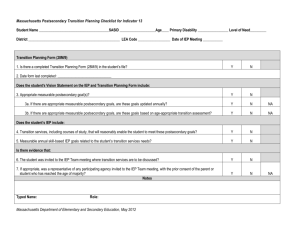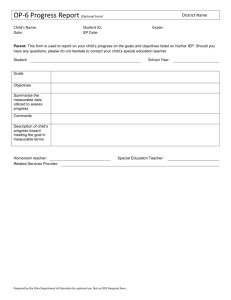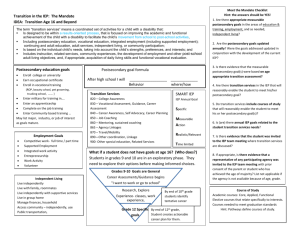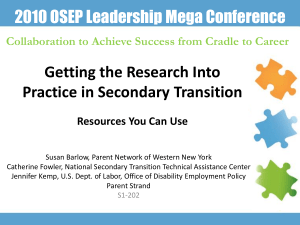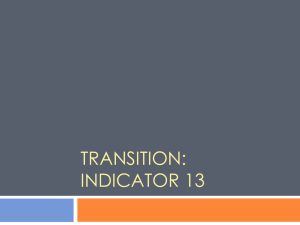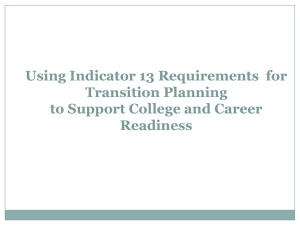PSG_trng08_1_
advertisement
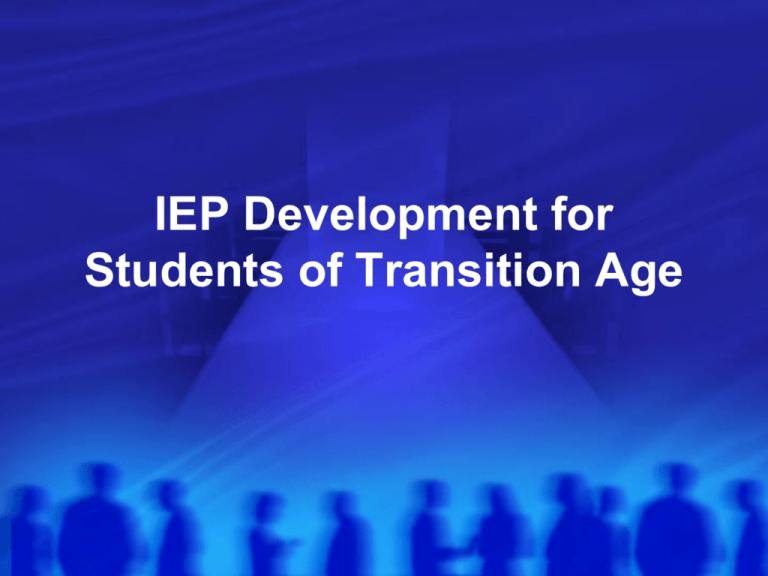
IEP Development for Students of Transition Age ODE is Finding….. Based on paper reviews/on-sites, the most common areas of non-compliance for PSG are: Writing Annual Goals as Post Secondary Goals. PSG written for students while still in school Goals that aren’t measurable Goals that are not based on any assessment Stating the student hasn’t made up his/her mind Haven’t considered PINS Student PINS Age Appropriate Transition Assessment Other Agencies Measurable Student Postsecondary Goals Annual Transition Goals Course of Study Transition Services Post Secondary Goals Annual Transition Goals After School Services End During High School Timeline for completion 1 year goal Measurable Measurable Based on Age Appropriate Transition Assessment Written in areas of: Education/Training Employment Independent living skills, when appropriate vs Based on student’s needs Written in areas of: Academic Functional Reasonably enabling the student to meet the postsecondary goals Age-appropriate Transition Assessments Help students make a connection between their individual academic program and their post-school ambitions Develop realistic and meaningful IEP goals Make instructional programming decisions Provide information for the PLAAFP related to the student’s PINS Learn about student career ambitions Inform the Summary of Performance Age-appropriate Transition Assessments Formal Transition Assessment Adaptive Behavior/Daily Living Skills General and Specific Aptitude Tests Interest Inventories Intelligence Tests Achievement Tests Temperament Inventories/Instruments Career Maturity or Employability Tests Self-Determination Assessment Transition Planning Inventories Formal and Free Examples Adaptive Behavior/Daily Living Skills http://www.caseylifeskills.org/index.htm Interest Inventories http://online.onetcenter.org/ http://www.khake.com/page3.html http://www.goarmy.com/CareerHelp.do?redirect=true http://www.qualityinfo.org/olmisj/OlmisZine?zineid=00000001 http://www.careeronestop.org http://www.employment.oregon.gov/ What else do you know about? Informal Transition Assessment Methods Interviews and questionnaires Direct observation Curriculum-based assessments (CBA) Environmental analysis http://www.nsttac.org/pdf/trans_fact_sheet.pdf Free and Informal Examples Person Centered Planning Tools http://thedesk.info/myplan/ Learning Styles or Preferences http://www.metamath.com/multiple/multiple_choice_question s.html Study Skills http://www.pvc.maricopa.edu/~lsche/resources/lrnr_asses/st udyskills.htm Fun http://www.soyouwanna.com/ Measurable Postsecondary Goal Criteria: • Education/training, employment, independent living • AFTER leaving school services • Based on PINS • Timeline for completion • A clear completion of the goal (measurable) • Can be combined into one all-inclusive goal or two or three separate goals Postsecondary Education/Training and Employment Goals – General Examples College programs, Vocational Training Program Full-time or part-time independent, competitive employment Full-time or part-time supported employment Employment through a mobile work crew or enclave Employment through a community rehabilitation program (sheltered) Volunteerism or community service work or other productive vocational activities Independent Living Postsecondary Goals – General Examples Living at home with parents or relatives Living independently in a house or apartment Group Home Supervised Apartment Living Alternative Family Living Domiciliary Care Home Financial Management Examples After graduation student will participate in transition program focusing on employment and independent living skills. Student will explore career options in the area of carpentry and secure drivers permit. Courses of Study Do the transition services include courses of study that focus on improving the academic and functional achievement of the child to facilitate their movement from school to post-school? Must be updated annually Help student meet his postsecondary goal Reflect multi-year coursework (series of courses) Address classes, experiences, and activities Motivate the student to complete his education Support post-school outcomes. Other Agencies For transition services that are likely to be provided or paid for by other agencies, is there evidence that representatives of the agencies were invited to the IEP meeting? For the current year, is there evidence in the IEP that representatives of any of the following agencies were invited to participate in the IEP development: postsecondary education, vocational education, integrated employment (including supported employment), continuing and adult education, adult services, independent living or community participation Was consent to attend obtained from the parent (or child, for a student of the age of majority)? Transition Services Are there transition services in the IEP that focus on improving the academic and functional achievement of the child to facilitate their movement from school to post-school? Must be a type of instruction, related service, community experience, development of employment post-school adult living objectives, acquisition of daily living skills, provision of a functional vocational evaluation listed in association with meeting the post-secondary goal(s). Annual IEP Goals Are there annual IEP goals that will reasonably enable the child to meet the postsecondary goals? For each postsecondary goal there must be an annual goal, based on present levels, included in the IEP that will help the student make progress towards the postsecondary goal. And That Ain’t No Shit Happy Holidays!
